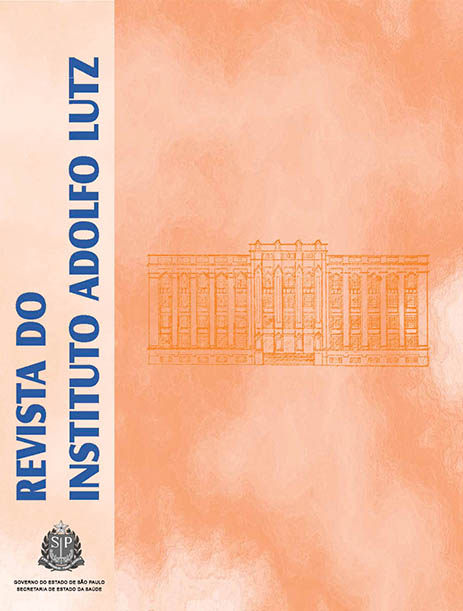Abstract
Histoplasmosis is a systemic mycosis caused by Histoplasma capsulatum. Human infection occurs by inhaling the microconidia found in soil contaminated with birds and/or bats excrements. In this study, the potential risk of infection with Histoplasma from practicing professional activities in caves was emphasized. Information on the fieldwork conducted by a group of 15 biologists were obtained through a semi-structured questionnaire; and the presence of antibodies anti-H. capsulatum was evaluated in their serum samples. The data analysis showed that 87% of subjects reported the frequent cave exploration, 53% camping inside the caves, 33% bats capturing activities, and 53% soil samples collection. The majority of the caves are located in the Southeast and Midwest regions of Brazil. By using double immunodiffusion assay, 20% of sera reacted with H. capsulatum antigen. By immunoblotting, it was found 94.1% of specific recognition of 94 kDa fraction, suggesting that the individuals had contact with the fungus. This study strongly suggests that the individuals practicing speleology were prone to fungal species exposure, which inhabit the environment as saprophytes, especially H. capsulatum, and it might characterize a potential risk factor for infections.References
1. Guimarães AJ, Nosanchuk JD, Zancopé-Oliveira RM. Diagnosis of histoplasmosis. Braz J Microbiol. 2006;37:1-13.
2. Ferreira MS, Borges AS. Histoplasmosis. Rev Soc Bras Med Trop. 2009;42(2):192-8.
3. Wheat LJ, Kauffman CA. Histoplasmosis. Infect Dis Clin North Am. 2003;17(1):1-19.
4. Wheat LJ. Current diagnosis of histoplasmosis. Trends Microbiol. 2003;11(10):488-94.
5. Panackal AA, Hajjeh RA, Cetron MS, Warnock DW. Fungal infections among returning travelers. Clin Infect Dis. 2002;35(9):1088-95.
6. Manzini EJ. Considerações sobre a elaboração de roteiro para entrevista semiestruturada. In: Marquezine MC, Almeida MA, Omote S, organizadores. Colóquios sobre pesquisa em Educação Especial. Londrina: Eduel; 2003. p.11-2.
7. Kaufman ED, Standard P. Fungal exoantigens. In: Drouhet E, Cole GT, Repentigny L, Latge JP, Dupont B, editors. Fungal antigens. Isolation, purification and detection. New York and London: Plenum Press; 1988. p.111-2.
8. Ouchterlony, O. Antigen-antibody reactions in gels. Acta Pathol Microbiol Scand. 1949;26(4):507-15.
9. Towbin H, Staehelin T, Gordon J. Electrophoretic transfer of proteins from polyacrylamide gels to nitrocellulose sheets: procedure and some applications. Proc Natl Acad Sci USA. 1979;76(9):4350-4.
10. Schmidt S, Machado OP, Galvão AB. Microepidemia de histoplasmose em zona rural de Brasília-DF. II Estudo epidemiológico e parasitológico da fonte de infecção. Rev Soc Bras Med Trop. 1973;7:107-15.
11. Suzaki A, Kimura M, Kimura S, Shimada K, Miyaji M, Kaufman L. An outbreak of acute pulmonary histoplasmosis among travelers to a bat-inhabited cave in Brazil. Kansenshogaku Zasshi. 1995;69(4):444-9.
12. Jülg B, Elias J, Zahn A, Köppen S, Becker-Gaab C, Bogner JR. Bat-associated histoplasmosis can be transmitted at entrances of bat caves and not only inside the caves. J Travel Med. 2008;15(2):133-6.
13. Silva-Vergara ML, Martinez R, Borges-Malta ME, Leite-Maffei CM, Ramirez LE. Histoplasma capsulatum isolated from Didelphis albiventris (Marsupialia Didelphidae) in the state of Minas Gerais, Brazil. Rev Iberoam Micol. 2001;18(4):180-2.
14. Erkens K, Lademann M, Tintelnot K, Lafrenz M, Kaben U, Reisinger EC. Histoplasmosis group disease in bat researchers returning from Cuba. Dtsch Med Wochenschr. 2002;127(1-2):21-5.
15. Vicentini-Moreira AP, Kohara VS, Passos AN, Feliciano RS, Barreto LC, Freitas RS, et al. Microepidemia de histoplasmose no município de Arapeí, São Paulo. BEPA. 2008;5(58):8-11.

This work is licensed under a Creative Commons Attribution 4.0 International License.
Copyright (c) 2012 Instituto Adolfo Lutz Journal
